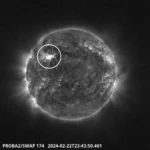Aurora Alert: Multiple CMEs May Trigger G2 Storms on Oct 16–17 (UTC)
CMEs from sunspot region AR4246 (launched Oct 11–13) are forecast to reach Earth between Oct 15 and 17. A G2 (moderate) watch is in place for late Oct 16, with G1 conditions possible into Oct 17.

According to the NOAA Space Weather Prediction Center G2 Watch, CMEs that left the Sun on Oct 11–13 could produce isolated G2 activity late on Oct 16 (UTC) and G1 into Oct 17. Visibility can extend to northern U.S. states such as Idaho and New York when conditions align. For previous visibility windows and background, see our coverage on G2 aurora opportunities and G4-driven visibility.
Forecast language points to clustered arrivals with a peak window on Oct 16. NOAA’s scale ranks G2 as “moderate,” which can lead to weak to moderate power grid fluctuations and minor satellite impacts under certain configurations. For real-time context on solar wind and IMF orientation, refer to the SWPC dashboard. For prior explainers on space weather tools and risks, see AI nowcasting for solar storms and satellite lifespan impacts.
- Window: Oct 15–17 (UTC), with late Oct 16 favored for G2.
- Source region: AR4246; multiple CMEs launched Oct 11–13.
- Expected level: G2 → G1; aurora potential at higher latitudes, sometimes into northern U.S.
Timeline slider
Move the slider to view the forecast window outlined in official bulletins.
Aurora checker (simple)
Select a region to see the general expectation under G2→G1 conditions.
Aurora basics – quick 3‑Q quiz
Official resources
Related coverage on Karmactive
- Northern lights across 16 states during KP5
- G3 storm over Washington
- G4 activity and U.S. visibility
- G2 window: 14 U.S. states
- Aurora over the UK
- AI for storm nowcasting
- Radio blackout during X2.7 flare
- Solar storms & satellite lifespans
- UK AENEAS forecasting
- Parker Solar Probe close pass
- Unprecedented U.S. sightings
- X1.1 flare & radio blackouts
- ISS crosses Sun during flare
The bulletin window and expected levels were outlined above. The dates, source region, and visibility notes were included for reference.

















